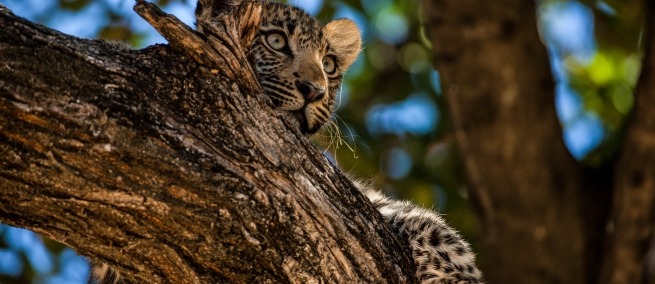
Beverly and Dereck Joubert–explorers, conservationists, and filmmakers–represent the interdependencies of animals, plants, and landscape within Africa’s Okavango Delta–a UNESCO World Heritage Sight–in their newest film OKAVANGO: RIVER OF DREAMS. The documentary, which premiered at the 2020 Sundance Film Festival, took four years of intense filmmaking to shoot, including a freak accident that threatened their lives. At Sundance, we sat down with Beverly and Dereck to discuss the film.
Science & Film: In capturing footage for this documentary, what stories came most easily, and which were the more difficult to shoot?
Beverly Joubert: We’ve had the luxury of studying this area for forty odd years, so we could storyboard what we really wanted. Our wish list was large, but meant that we did need that luxury of time.
Dereck Joubert: There’s nothing easy about this kind of thing; I wish it were easy. Some things you don’t anticipate and just happen across, and they can be the real gems. We wanted to film in this style which was a hand-over–so one animal hands over to the next, to the next, to the river, back again. So, for example, we filmed some brightly colored carmine beetles–beautiful, scarlet colored–and then we were working with some lions and the carmine beetles flew right between us, so that’s a moment you capture, you don’t work on it for four months—it just happens and you never see it again.
Beverly Joubert: When we first took on the project, we said it would take three years. And then, something unforeseen happened—we had a freak accident with a buffalo that hit Dereck and I, and so that took us out of action for nine months.
S&F: Injured you?
BJ: We were seriously injured, yeah. I was in the hospital for three months.
S&F: What happened exactly, if you don’t mind my asking?
BJ: It was a freak accident. The buffalo was wounded, he was walking in our camp, he was probably using the camp as a safe haven, and we walked from one tent to the other with flashlights, and it was quarter to eight at night, and he came out of darkness, gave us three or four snorts, but he just targeted us. He came straight for us and I just stood still and looked and said oh no, and Derek said go away or whatever he said.
DJ: I jumped forward and yelled at him…
BJ: And he went through us. Dereck was hit and went flying, and I was impaled seconds after that, and he ran off with me. So that’s why it was such a serious accident. Dereck then had to try and get himself up after being hit by a two-ton creature and run after and try and get me off. So, I don’t know how much time you’ve got, but…
DJ: I ran after the buffalo and he flicked Beverly off the horns and then she crumpled down and then the buffalo came back, and so I had to run at him and draw him off and carry Beverly halfway back to the other tent. But what was trickier was that we couldn’t get out, because it was nighttime, so for the next 18 hours before I could get her to a hospital, I had to administer first aid.
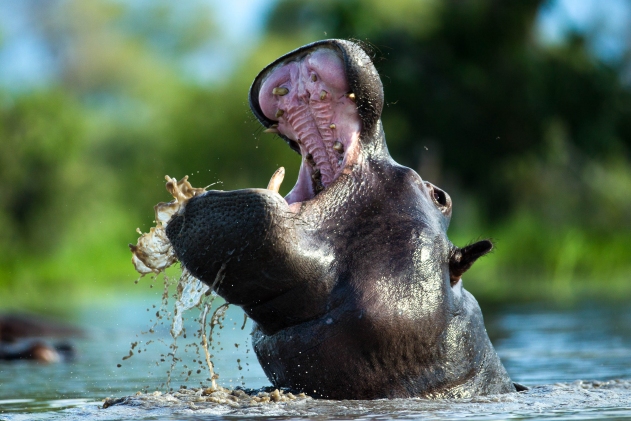
Courtesy of Sundance Institute, photo by Beverly Joubert
S&F: I’m glad you survived!
DJ: It was a big buffalo horn, and it went under Beverly’s arm, through her throat, into her cheek.
BJ: 27 bones broken.
S&F: WHAT?!
BJ: I now live with seven plates and 44 screws and a big plate here [gestures].
S&F: I mean, I can’t see anything.
BJ: I had 7 different surgeons to save my life.
S&F: Did that shake your resolve in terms of making the film or living in the Okavango?
BJ: The process that the caterpillar goes through to become a butterfly, not to say that I’m a butterfly, but I went through a metamorphosis and I think we embraced our calling, or our cause, so much more strongly in every way. We had a lot more empathy toward the wildlife and what they experience, and we definitely have a better understanding about what’s happening to this planet right now. We almost look at what happened to us as a symbol of what’s happening to the planet.
DJ: I think it strengthened our resolve to do something about it, and to stop looking down, to look up. It wasn’t the buffalo’s fault, it wasn’t our fault, it wasn’t anybody’s fault, and Africa is gritty, bad shit happens. But it doesn’t mean that Africa is bad. One looks at that more philosophically, and we’re now using the time that we do have more intensely than before to try and save the planet before the next buffalo [laughs].
S&F: That is very remarkable, very impressive resolve. I think for a lot of people, you could imagine a different reaction.
DJ: The weirdest thing is we go off, we were in the hospital for all this time, I’m reading Dante, going to dark places–
BJ: In a dark place already.
DJ: –and within days of coming out, we ran into some buffalo and so we spent, strategically, quite a bit of time with the buffalo, in and out of the vehicle, getting our ski legs back. Just making sure that we didn’t feel anything. Through some of that time I questioned whether Africa was rejecting us, so I knew that I needed to get out and touch the ground and make sure that we were still friends, you know?
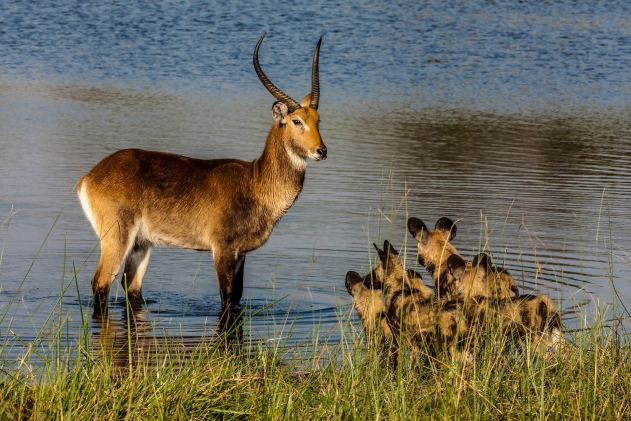
Courtesy of Sundance Institute, photo by Beverly Joubert
S&F: So, getting back to the filming process: When you’re thinking about what you want to capture, are you thinking about it in conversation with scientific research, or is it purely aesthetic? What is that balance?
DJ: With our films, we research, we look at the science, we read everything we can, and then we sort of push it aside. But one of the scenes in the film I had first heard of as a possibility of happening forty years ago maybe: we came across this big termite mound and den, and hyenas were digging in there and a warthog walks in. They shared this den. It was urban myth in many ways, and so now we’ve captured it on film.
Certain subjects—lions in particular, and all the big cats—we’ve researched it our whole lives, we’ve written papers on it. The conversation is between science that we know and nature itself. In all of our films in the past, we’ve discovered something that science up to that point did not know—lions jumping on elephants, for example. These moments just suddenly erupt, and nobody’s ever seen them, and suddenly you start seeing them. For us, it’s understanding the science, and then being open to the conversation [with nature].
S&F: Do you think you’ve been able to capture these moments that perhaps were not known of before because you’re filmmakers? Because you’re spending so much time looking?
BJ: Time is the ultimate… you couldn’t go for three months and expect to come up with OKAVANGO as we have it now, purely because many of the scenes are of different seasons. We wanted to have the water as one of the main characters—following the water and then going into the desert, into complete dryness, where animals like zebra migrate down to this very hot, uncomfortable desert, just as the rains hit. The area that we were covering, it must’ve been…
DJ: 15,000 square miles
BJ: It’s huge. We used every tool that we could– helicopters and drones–and it was a wonderful way to show this area and the patterns. Animals have become the artists, because in the desert, where there’s just a little bit of moisture, they’re creating different patterns, and it’s the canvas of the sand that’s the art. In the delta, elephants are masters of change there, and they’re important. Without them, channels would get blocked. But as they are masters of change, they also create these new intricate and unique patterns. And they’re opening it up for other animals. We were concentrating on that as well, because the whole concept of the film is: let’s look at this world heritage site, it’s one of the last pristine places on Earth, and it’s vulnerable. Ultimately, how can we protect it?
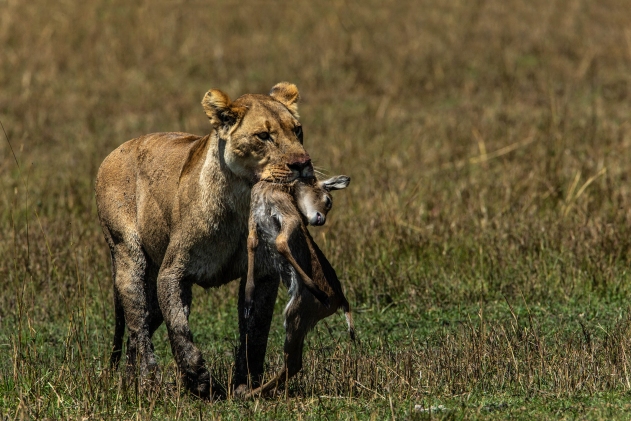
Courtesy of Sundance Institute, photo by Beverly Joubert
DJ: Time is our secret weapon. We don’t do films quickly. It takes us that long to get into the skin of it. To understand it.
BJ: Sometimes we have to go through the pain, the agony, of watching an animal go through their own traumas. And we love that. We do. We take it on, we love it, we feel it, and we try and bring that out at the end of the day with Dereck writing the script. But even in the edit phase, we look at those moments that are going to be the tender, moments that are going to get you as the audience to feel that emotion.
DJ: This film, more than others that we’ve done, is a mirror, both to ourselves and to the audience, because of the journey, which has a beginning middle and end: the river starts in the hills and ends in the desert, unlike many others that end in the ocean. So it’s got that journey, and that is a reflection of our journey that we had through this film.
S&F: You mean physically, following the river?
DJ: Yes physically, and emotionally, and after we had the accident with the buffalo–Beverly was in the hospital for all those months, I was really Dante, because Beverly died a few times and we got her back. I was reading Dante, to explore the depth of the darkness and the agony of life. When we were structuring this film, we parallel Dante’s journey in the Divine Comedy from purgatory into paradise which in many ways reflected Beverly’s recovery—the journey of the river from the desert and then making our way through paradise. There are many, many layers [in the film] and I’m hoping that audiences will understand, or at least be sensitized, to some of those. We say things in the script like, someone’s paradise is someone else’s purgatory. Little things so that you start thinking not so much about the lion or the elephant, but yourself.
Almost everybody in the world is waking up and rushing to the news, because we’re all caught up in this collective post-traumatic stress about what’s happening to the planet. To do a film about someplace where it’s pristine and whole and pure is an example. If everything else falls apart, we will have the Okavango.
S&F: Do you think it will survive if everything else falls apart?
DJ: I think it’ll survive longer.
BJ: Many of the African countries that have the last remaining pristine place get a huge income through safari tourism. That’s one way that it’s been protected. But there is an overwhelming swell of humanity and of course everybody needs space, so slowly that space is encroached upon. It happens little by little until you realize, oh my gosh, half of the park is gone. That is the danger. I’ve books like Jared Diamond’s Collapse, and he writes that we will have wildlife, but it will be in enclosed areas; it’ll be in zoos or theme parks and various places. We find that a bleak situation.
We started the Big Cats Initiative at National Geographic—we are trying to protect lions and leopards and cheetahs, and that’s in Africa, but then looking at all cats around the world, and, yes, it is important to protect all of them, but each initiative we take on is really about protecting the wilderness for them at the same time because without the wilderness, then we really should just be putting them in zoos right now. How do we protect the environment and protect the delta so that safari hunting doesn’t go into it? We took 25 years of working with the government in Botswana just to advocate against hunting and they eventually stopped hunting in 2014.
And now it’s being reopened in 2020 in April because of a new president. We find that devastating. In our opinion, it’s the wrong decision, but that’s a decision that’s been made, and it’s a decision that we have to look at and how it’s going to affect the area.
DJ: It’s easy to look at these places and say, this is 15,000 square kilometers, it’s huge. And then you step back and look at it, it’s basically in the palm of our hand, and we could crush it. The future of this place is entirely in our hands. Our fear is that we’re busy abusing it already, and like all addictions, the first step is to understand that you have an abusive relationship. This film is pointing out exactly what we will be losing.
S&F: Was your main impetus for making the film to try and show that we have this beautiful place and that it needs protecting?
DJ: Yes, definitely. I think that there are some fundamental problems with our relationship to nature, and one of them is ignorance: we simply do not understand the impact that we have. The other [problem] is greed, and the other is necessity. We destroy it if we have to, to eat. With greed, we will destroy it. But if you’re aware, people at least can’t unknow something. The start of the film was to shine a spotlight on how pristine but also how intricate this place is. Now that you know that, you shouldn’t be participating in destroying it. It’s more fragile than you think, even though it’s big.
S&F: The film is so beautiful and so expansive, and then looking at the credits it’s really just the two of you who did everything. Is there anyone else who you want to mention, who was a key collaborator?
DJ: We brought in a high-speed cameraman for a couple of weeks, an underwater cameraman, and that sort of thing. But not enough can be said about our partners on the film: Terra Mater in particular. One year into the production, we had this buffalo accident that put me out of action, put Beverly in the hospital, and the production schedule was floating. They had made commitments to get the film out, and I phoned, and I said, this is going to set us back a year. And there was not a moment of: oh dear, let’s adjust the budget. All that I got from them was, don’t even think about that. You guys stay in hospital, get yourselves sorted out, we’ll put a freeze on the production and revisit later. That sort of compassion was embedded in the entire film.
BJ: Absolutely, they’ve been phenomenal, in every way. On the creative side, we’ve all had the same agenda which is, how can the film speak globally about the environment and conservation ethics? Often, broadcasters are shying from that. So it was really wonderful that we didn’t have to fight for that.
The other person worth mentioning is our editor Jolene van Antwerp. She truly was phenomenal. She put herself in our shoes, in the story’s shoes. She really loved the film through the whole period. We brought her on very early because we wanted her to be able to edit scenes as we were shooting them instead of just, here’s all the footage, and let’s see what we can make. And I believe that made the film better. The other two people are the two music composers. We had to share the music because of the volume of material, but also, we finished the film late so we didn’t have enough time for one music composer. Also, we wanted the yin and yang and so we brought Sarah Class on, who is a woman composer, and JB Arthur, who is a male composer, so that was great. They worked exceptionally well together. They worked a little bit like Dereck and I you know, being partners and just absorbing it and taking the ego out of it.
It was great apart from the little accident.
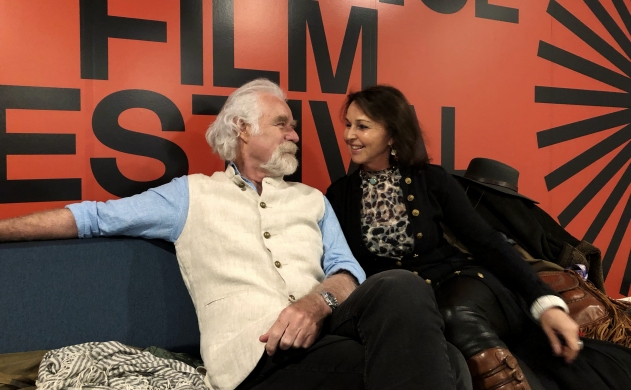
Dereck and Beverly Joubert, photo by Sonia Epstein
OKAVANGO: RIVER OF DREAMS (Director’s Cut) is directed and produced by Dereck and Beverly Joubert. Dereck Joubert also wrote and served as cinematographer, and narrates the film. Beverly Joubert did the sound design. The couple are each National Geographic explorers-at-large, and have made over 40 films together, received eight Emmys, a Peabody, and many more awards, and in addition to publishing over ten books and numerous articles.
TOPICS